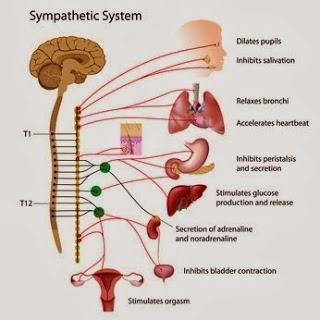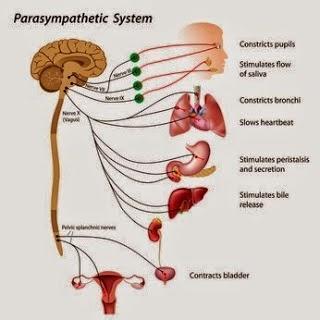An Examination at the Faculty of Medicine, Paris by Toulouse-Lautrec
We’re going to have an anatomy lesson today! I know, I know, you thought after you graduated, you wouldn’t need to be learning any more dry, technical stuff. But I swear to you this information is so useful that it could literally change your life (see 2 Steps to Take Charge of Your Stress or Anxiety). I know that because it has changed mine.So, take a deep breath and take a look at the autonomic nervous system. Your autonomic nervous system is the part of your nervous system that regulates involuntary body functions, such as heartbeat, blood flow, breathing, and digestion. It’s called “autonomic” (hahaha, I just learned this) because the system works autonomously (automatically) without your conscious effort. (You don’t need to tell your heart to beat the same way you need to tell your front knee to bend to 90 degrees in Warrior 2 pose. Voluntary movements, such as knee bending, are controlled by your somatic nervous system.)
Although the functions of the autonomic nervous system are generally outside of voluntary control, they are not outside of your awareness, and they may be influenced by your state of mind. For example, although you can’t tell your heart to beat faster or more slowly, you can feel it beating. And when you’re calm, you’ll notice that your heart beats more slowly and when you’re afraid or angry, you’ll notice it beating more rapidly.
Depending on which source you read, the autonomic nervous system is divided into two parts that function in tandem with each other: the Sympathetic Nervous System and the Parasympathetic Nervous system. After the autonomic nervous system receives information about your body and the external environment, it responds by stimulating body processes, usually through the sympathetic division, or inhibiting them, usually through the parasympathetic division. (Some sources also include the gut nervous system, the Enteric Nervous System, as a third, separate part of the ANS. But I’m not going to take a stand on that anatomical debate.)
About Your Sympathetic Nervous System
Your Sympathetic Nervous System (SNS) prepares your body for stressful or emergency situations. That’s why it is commonly called the Fight or Flight response. To prepare your body to deal with a challenging situation or an emergency, your SNS releases hormones—adrenaline and noradrenaline—to increase your heart rate, blood pressure, blood flow to the muscles, and widens (dilates) your airways to make breathing easier. It also causes your body to release stored energy and increases muscle strength is increased. After all, you might need to fight or run! Something that is mentioned less often, but that I’ve really noticed myself and which is really pertinent to yoga, is that your SNS causes your mind to race to increase your ability to assess your current situation and make important decisions.

In addition, because your body is working extra hard during stressful periods, it can just wear you out faster, which is why heart disease is associated with stress. And having a racing mind all the time, well, that causes emotional problems, such as anxiety and depression, as well as insomnia because you can’t let go and just fall asleep. All this why chronic stress is so harmful to your physical as well as emotional health (see Chronic Stress: An Introduction and Stress, Your Health, and Yoga for more info about chronic stress.)
We can’t and should not eliminate stress entirely from our lives. Sometimes in the modern world we do need to get out of danger, including mundane situations such as getting out of the way of an oncoming car, or more in more rare circumstances, such as protecting a family member from a threat. But our stress response also prepares us for some really good things in life, including running a race, traveling to a foreign country, having a creative brainstorm, falling in love with someone (that can be so scary, right?) or even —ahem—having an orgasm.
But problems arise when we’re living in a state of chronic stress due to demands of ongoing challenges, such as our job, commuting, or family problems. In this case, understanding what the symptoms of stress are can help you identify your current state. Because when you realize you’re stressed out, you can and should try to reduce your stress levels. And the thing that most people don’t realize is that you can intentionally change your nervous system from being in the stress mode triggered by your SNS to a different state.
About Your Parasympathetic Nervous System
Your Parasympathetic Nervous System (PNS) controls your controls body process during ordinary situations, enabling you to recover from stressful periods. That’s why it is sometimes called the Rest and Digest response. The PNS reduces the levels of stress hormones in your body, slowing your heart rate, decreasing blood pressure, and so on. After all, these organs don’t need to work as hard now that the stressful situation has passed. And, now that you’re out of danger, your racing mind will also slow down and you’ll experience feelings of relaxation (the PNS is also sometimes called the Relaxation Response). 
It’s important to understand that Rest and Digest state is quite different than sleep (see Conscious Relaxation vs. Sleep). That’s why sleeping—if you can sleep—doesn’t fix stress-related problems, such as heart disease, high blood pressure, headaches, digestive problems, and so on. And, as you may have noticed, sleep also doesn’t quiet your mind, either, as many stressed people spend their days feeling anxious or wake in the middle of the night with a racing mind. That has a profound effect on your emotional well-being. So the bottom line is that if you want to do your best to protect both your physical and emotional health, you need to make an effort to less time in stress mode and more time in conscious relaxation mode.
But, if your autonomic nervous system is “automatic,” how exactly can you change it?
Influencing Your Autonomic Nervous System with Yoga
Remember, I said earlier that although the functions of your autonomic nervous system are generally outside of voluntary control, they may be influenced by your state of mind. I also said that the autonomic nervous system responds to information that it receives from both your body and the external environment. And this is why yoga is such a powerful solution for managing stress.
Quieting Your Mind. Yes, it turns out the original purpose of yoga described in the Yoga Sutras as “the stilling of the changing states of the mind” is one of the keys. By meditating—which typically involves concentrating on a non-stressful sight, sound, or physical sensation—you can quiet your mind. This in turn switches your nervous system from stress mode to relaxation mode. (See The Relaxation Response by Dr. Herbert Bensen for complete information on this.)Working with Your Breath. It also turns out that pranayama—or breath control—allows you access your nervous system. By slowing your breath, as it would be in a state of relaxation, you can actually switch your nervous system from stress mode to relaxation mode. Baxter described how this works in his post How Your Breath Affects Your Nervous System.
Working with Your Environment. Finally, you can use your asana practice to create physical environment that will encourage your nervous system switch from stress mode to relaxation mode. Practicing relaxing or quieting yoga poses, such as restorative poses and supported forward bends, in a warm room, will send messages to your nervous system that you’re safe and comfortable. Yoga nidra and other forms of guided relaxation that you practice in Savasana will have the same effect. Inverted poses are a special case because these yoga poses take advantage of the mechanisms in your body that control your blood pressure to “trick” your nervous system into switching into relaxation mode (see Why You Should Love Your Baroreceptors).
See The Relaxation Response and Yoga for more information about how you can use yoga to trigger the relaxation response.
Well, it seems I’ve gone on much longer than I expected, but I felt I had some important things to explain. For those of you who didn’t already know this information about the nervous system, I hope you will find it as compelling as I do, and that it will empower you to deal more effectively with stressful situations and reduce your overall stress levels.Subscribe to YOGA FOR HEALTHY AGING by Email ° Follow Yoga for Healthy Aging on Facebook


